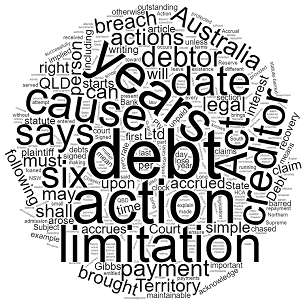Table of Contents
Toggle- What is the statute of limitation for debts in Australia?
- Cause of Action Accrual in Contract
- Fresh Accrual of Action
- Signed Acknowledgement of Debt
- When does the Limitation Period Start?
- What About Debts Secured by Mortgage?
- What is a Statute-Barred Debt?
- Can you collect Statute-Barred Debts?
- How do I know if a Debt is Statute Barred?
- Preserving the rights of the Creditor
- What if Judgment has been Entered Against a Debtor?
- How Long can a Debt be Chased in Australia?
- How Long can a Debt be Chased in New South Wales
- How Long can a Debt be Chased in South Australia
- How Long can a Debt be Chased in Tasmania
- How Long can a Debt be Chased in Victoria
- How Long can a Debt be Chased in Western Australia
- How Long can a Debt be Chased in Australian Capital Territory
- How Long can a Debt be Chased in Northern Territory
- How Long can a Debt be Chased in Australia?
- How Long can a Debt be Chased in Australia FAQ
- What is a Statute-Barred Debt?
- Can you collect Statute-Barred Debts?
- How do I know if a Debt is Statute Barred?
- How Long can a Debt be Chased in Australia?
- How long can I enforce a judgment for?
- How long can a debt be chased in Australia?
- What does it mean when a debt is “statute barred”?
- What is the implication of acknowledging a debt?
- When does the limitation period start?
- What about debts secured by a mortgage?
- Can I collect on statute-barred debts?
- How do I determine if a debt is statute-barred?
- What happens if a judgment is entered against a debtor?
- How long can a debt be chased in other Australian regions?
- What should I do if the limitation date for my debt is nearing?
 Have you ever wondered how long can a debt be chased in Australia?
Have you ever wondered how long can a debt be chased in Australia?
In most states (except NT) the limitation period for most debts is six (6) years.
This is contingent on a number of different factors and so it is vital that you get the calculations correct.
Failure to realise the limitation period could mean that you will be unable to successfully recover your debts and they will become statute barred.
This article will explain how long a debt can be chased in Australia and explain the six (6) year limitation period, and the concept of a debt being statute barred.
In this article our debt recovery lawyers will use Queensland legislation and cases however the limitation of actions acts in every State and Territory have a lot of the same concepts.
Check the bottom of this article for the limitation period in your State or Territory to understand how long can a debt be chased in Australia.
If you have ever asked yourself how long can a debt be chased in Australia, and the limitation date is approaching, then contact our debt recovery lawyers today
What is the statute of limitation for debts in Australia?
If you have ever asked how long can a debt be chased in Queensland, the limitation period for the recovery of a debt is six (6) years unless legal action has been commenced.
Section 10 of the Limitation of Actions Act 1974 (QLD) says:
(1) The following actions shall not be brought after the expiration of 6 years from the date on which the cause of action arose—
(a) … an action founded on simple contract or quasi-contract …
So, the only question left to answer is when does a cause of action arise in a debt dispute?
Cause of Action Accrual in Contract
Gibbs v Guild (1882) 9 QBD 59 is the authority that a cause of action in contract accrues at the time of the breach, not at the time the damage is sustained.
In the more recent matter of UGL Rail Pty Ltd v Wilkinson Murray Pty Ltd [2014] NSWSC 1959 the NSW Supreme Court upheld that saying:
A cause of action for breach of contract first accrues when the breach occurs: Gibbs v Guild (1881) 8 QBD 296 at 302 per Field J; Hawkins v Clayton [1988] HCA 15; (1988) 164 CLR 539 at 583 per Deane J; Nykredit Mortgage Bank Plc v Edward Erdman Group Ltd (No 2) [1997] UKHL 53; [1998] 1 All ER 305 at 308 per Nicholls LJ.
Usually, a breach of the contract will be defined in the contract.
If not, then it is likely to be the day after the last day for payment of the invoice. If your payment terms are fourteen (14) days, then breach occurs at the time of the breach. This is when the clock starts ticking.
Fresh Accrual of Action
It is possible for the six (6) year limitation period to start again, essentially restarting the clock.
Section 35(3) of the Limitation of Actions Act 1974 (QLD) says:
Where a right of action has accrued to recover a debt or other liquidated pecuniary claim … and the person liable or accountable therefor acknowledges the claim or makes a payment in respect thereof, the right shall be deemed to have accrued on and not before the date of the acknowledgment or the last payment.
This means that upon the acknowledgement of the debt, or payment made the limitation period starts on that date.
The Act then goes on to prescribe the formal requirements needed for an acknowledgement of debt and/or part-payment.
Section 36 of the Limitation of Actions Act 1974 (QLD) says:
Every acknowledgment referred to in section 35 shall be in writing and signed by the person making the acknowledgment
This means that a debtor may acknowledge the debt, but that acknowledgement must be in writing and must be signed by the debtor.
So, an acknowledgment of the debt must be “in writing” and “signed by the person” or the persons agent for it to be effective. But what does this mean?
Signed Acknowledgement of Debt
In Stage Club Ltd v Millers Hotels Pty Ltd [1981] HCA 71 Gibbs CJ said:
Where the claim is for payment of a debt, an acknowledgment, to be sufficient, must recognize the present existence of the debt.
Gibbs CJ then agreed with Kerr J in Surrendra Overseas Ltd v Government of Sri Lanka [1977] 1 WLR 565 who said that:
To acknowledge a claim, as a matter of ordinary English, signifies an admission that it is due. There is no acknowledgment of a debt unless there is an admission that there is a debt . . . outstanding and unpaid.
For an acknowledgement of debt, the debt must be acknowledged:
- In writing; and
- Signed by the person making the acknowledgement; and
- Recognise the present existence of the debt; and
- Admits that the debt is outstanding and unpaid.
Tip – if the limitation period is coming close, ask the debtor to acknowledge the debt, or make a small payment. This resets the clock on the six (6) year limitation period.
When does the Limitation Period Start?
The limitation period starts at different times depending on the circumstances of your case.
If a debt is loaned without any terms for repayment, then the loan is repayable on demand. This means that the limitation period starts on the day that the actual money is loaned, or upon the date of the last repayment.
If the debt is based upon a breach of contract, then the limitation period starts on the date of the breach of the contract.
It is important that a creditor knows exactly when the limitation date started, otherwise they may lose out on the right to recover that debt.
What About Debts Secured by Mortgage?
Section 26(1) of the Limitation Of Actions Act 1974 (Qld) says:
An action shall not be brought to recover a principal sum of money secured by a mortgage or other charge on property whether real or personal nor to recover proceeds of the sale of land after the expiration of 12 years from the date on which the right to receive the money accrued.
This means that if the debt is secured by a mortgage or other charge on the property, the limitation period is twelve (12) years.
What is a Statute-Barred Debt?
A statute-barred debt is a debt which is older than the limitation period in your State or Territory, to which no payments have been made, and there has been no acknowledgement.
For example, if a debtor owes a creditor and the debtor tries to disappear (interstate etc) in an attempt to escape paying for the debt, and successfully does so for six (6) years (in Queensland) then the creditor cannot recover the debt.
This is unless the creditor brings an action “founded on simple contract or quasi-contract” as per the Act. All a creditor has to do is correctly bring the action to preserve their rights.
Can you collect Statute-Barred Debts?
A creditor has no legal right of recovery for statute-barred debts.
You can still attempt to negotiate with the debtor, but a creditor must not threaten any legal action, as they are not allowed to bring any.
If a debtor knows that the debt is unenforceable, then this could be a futile exercise, and there will be penalties if a creditor attempts to mislead or deceive the debtor.
How do I know if a Debt is Statute Barred?
How long can a debt be chased in Australia if it has been six (6) years since a creditor has received a payment toward the debt, and there has been no written correspondence between the parties acknowledging the debt, then there is a good chance that the debt is now statute barred.
It is very important that this calculation is done correctly, or a creditor may lose their right to recover the debt.
For example, the debtor may have received a small payment which has been forgotten about, or the acknowledgement of debt is not a valid acknowledgement.
It is very important to seek qualified legal advice to ensure that your rights are protected.
Preserving the rights of the Creditor
If you have ever asked yourself how long can a debt be chased in Australia, in Queensland Section 10 of the Limitation of Actions Act 1974 (QLD) says that an action on simple contract or quasi-contract cannot be brought after the expiration of 6 years from the date on which the cause of action arose.
However, if a creditor brings the action, or commences legal action, to recover the debt, then this preserves the creditor’s rights.
For example – a creditor can wait for five (5) years and fifty (50) weeks and receive no payments toward the debt, then file proceedings in the Court with jurisdiction, and it satisfies section 10 of the Act.
The creditor is also entitled to claim interest on the outstanding debt pursuant to section 58 of the Civil Proceedings Act 2011 (QLD) which says:
The court may order that there be included in the amount for which judgment is given interest at the rate the court considers appropriate for all or part of the amount and for all or part of the period between the date when the cause of action arose and the date of judgment.
The Supreme Court Practice Direction Number 7 of 2013 says that interest is calculated at 4% above the cash rate at the Reserve Bank of Australia.
This may mean that a $15,000.00 unpaid debt, a little less than six (6) years from the date of this article, the Court Interest Calculator says that the interest amount is $5,698.50 bringing the total owing to $20,698.50. This is a considerable amount to be added.
Once filed, the debtor needs to be served with the proceeding. If the debtor continues to do nothing after being served, then a creditor can request that judgment be entered against them.
What if Judgment has been Entered Against a Debtor?
How long can a debt be chased in Australia if judgment is entered against the debtor, then the creditor has a statutory limit of twelve (12) years to enforce the judgment debt. This includes six (6) years without leave of the Court, and a further six (6) years with leave of the court.
Section 10(4) of the Limitation of Actions Act 1974 (QLD) says:
An action shall not be brought upon a judgment after the expiration of 12 years from the date on which the judgment becomes enforceable.
The creditor is also entitled to post-judgment interest in the amount of 6% above the cash rate at the Reserve Bank of Australia.
How Long can a Debt be Chased in Australia?
As outlined above, in Queensland a debt can only be chased for six (6) years after the cause of action arose. Other States have similar legislation.
How Long can a Debt be Chased in New South Wales
Section 14 of the Limitation Act 1969 (NSW) says:
An action on any of the following causes of action is not maintainable if brought after the expiration of a limitation period of six years running from the date on which the cause of action first accrues to the plaintiff or to a person through whom the plaintiff claims:
(a) a cause of action founded on contract (including quasi contract)
How Long can a Debt be Chased in South Australia
Section 35 of the Limitation of Actions Act 1936 (SA) says:
The following actions namely … actions founded upon any simple contract express or implied, or upon any award where the submission is not by specialty … shall, save as otherwise provided in this Act, be commenced within six years next after the cause of action accrued and not after.
How Long can a Debt be Chased in Tasmania
Section 4 of the Limitation Act 1974 (TAS) says:
Except as otherwise provided in this Division, the following actions shall not be brought after the expiration of 6 years from the date on which the cause of action accrued, that is to say:
(a) actions founded on simple contract (including contract implied by law)
How Long can a Debt be Chased in Victoria
Section 5 of the Limitation of Actions Act 1958 (VIC) says:
The following actions shall not be brought after the expiration of six years from the date on which the cause of action accrued—
(a) Subject to subsections (1AAA), (1AA) and (1A), actions founded on simple contract (including contract implied in law)
How Long can a Debt be Chased in Western Australia
Section 13 of the Limitation Act 2005 (WA) says:
An action on any cause of action cannot be commenced if 6 years have elapsed since the cause of action accrued.
How Long can a Debt be Chased in Australian Capital Territory
Section 11 of the Limitation Act 1985 (ACT) says:
Subject to subsection (2), an action on any cause of action is not maintainable if brought after the end of a limitation period of 6 years running from the date when the cause of action first accrues to the plaintiff or to a person through whom he or she claims.
How Long can a Debt be Chased in Northern Territory
Section 12 of the Limitation Act (NT) says:
Subject to subsection (2), the following actions are not maintainable after the expiration of a limitation period of 3 years from the date on which the cause of action first accrues to the plaintiff or to a person through whom he claims:
(a) an action founded on contract (including quasi-contract) not being a cause of action which is evidenced by a deed
How Long can a Debt be Chased in Australia?
In every State and Territory in Australia, the usual limitation time is six (6) years, except in the Northern Territory where it is three (3) years.
If you want to legally enforce your rights in the Courts then you must commence legal action before this time or you may lose your legal right of recovery.
We always recommend using a debt recovery lawyer to ensure that your legal rights are protected.
How Long can a Debt be Chased in Australia FAQ
Navigating the realm of debt recovery in Australia can often appear intricate and daunting.
With different rules and timeframes governing how and when you can chase debts, understanding your rights as a creditor is paramount.
Here are some commonly asked questions about this topic to help you unravel the complexities surrounding it.
What is a Statute-Barred Debt?
A statute-barred debt is a debt which is older than the limitation period in your State or Territory, to which no payments have been made, and there has been no acknowledgement.
Can you collect Statute-Barred Debts?
A creditor has no legal right of recovery for statute-barred debts.
How do I know if a Debt is Statute Barred?
If it has been six (6) years since a creditor has received a payment toward the debt, and there has been no written correspondence between the parties acknowledging the debt, then there is a good chance that the debt is now statute barred.
How Long can a Debt be Chased in Australia?
In every State and Territory in Australia, the usual limitation time is six (6) years, except in the Northern Territory where it is three (3) years.
How long can I enforce a judgment for?
If judgment is entered against the debtor, then the creditor has a statutory limit of twelve (12) years to enforce the judgment debt. This includes six (6) years without leave of the Court, and a further six (6) years with leave of the court.
How long can a debt be chased in Australia?
In most Australian states, the limitation period for most debts is six (6) years. However, in the Northern Territory, the limitation period is three (3) years.
What does it mean when a debt is “statute barred”?
A statute-barred debt is one that is older than the limitation period in your State or Territory, has received no payments, and has had no acknowledgment. For such debts, they cannot be legally recovered.
What is the implication of acknowledging a debt?
If a debtor acknowledges the debt or makes a payment towards it, the limitation period starts anew from that date. However, this acknowledgment must be in writing and signed by the debtor.
When does the limitation period start?
The start of the limitation period varies. For instance, if a debt is based on a loan without repayment terms, it starts on the day the money is loaned. For contract breaches, it begins on the breach date.
What about debts secured by a mortgage?
Debts secured by a mortgage or other charge on property have a limitation period of twelve (12) years.
Can I collect on statute-barred debts?
Legally, statute-barred debts cannot be recovered. You can negotiate, but threatening legal action is not permissible.
How do I determine if a debt is statute-barred?
If six (6) years have passed since a payment was made towards the debt and no written correspondence acknowledging the debt exists, the debt is likely statute-barred. It’s essential to calculate this correctly and seek legal advice if unsure.
What happens if a judgment is entered against a debtor?
If a judgment is entered, the creditor has twelve (12) years to enforce the judgment debt, with the first six (6) years not requiring court leave and the subsequent six (6) years needing court leave.
How long can a debt be chased in other Australian regions?
In New South Wales, South Australia, Tasmania, Victoria, Western Australia, and the Australian Capital Territory, the limitation period is six (6) years. In the Northern Territory, it’s three (3) years.
What should I do if the limitation date for my debt is nearing?
If the limitation date for recovering a debt is approaching, it is recommended to contact a debt recovery lawyer to ensure your legal rights are upheld and the appropriate action is taken.
If you have ever asked yourself how long can a debt be chased in Australia, and the limitation date is approaching, then contact our debt recovery lawyers today
DEDICATED FOCUS – COMMERCIALLY MINDED – PROVEN RESULTS
OR CALL: 1300 545 133 FOR A FREE PHONE CONSULTATION








